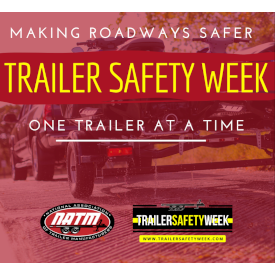Welcome to Trailer Safety Week

The following was submitted by Americana Tire and Wheel in honor of National Trailer Safety Week.Elkhart, Ind.-based Americana Tire and Wheel, Kenda’s distribution arm serving the North American towable trailer, utility, RV, marine and agricultural industries, is proud to support the National Association of Trailer Manufacturers’ third annual National Trailer Safety Week, June 7 to 13, as part of its ongoing commitment to safety through consumer education and the production of quality products to supply trailer manufacturers nationwide.Because there are so many variables and so little awareness, Trailer Safety Week is designed to make towing safer by educating trailer drivers and manufacturers on best practices. As part of its participation, ATW is sharing essential tips on proper towing and tire use.
Whether towing a boat to the lake, taking an RV to the campgrounds, or heading to the garden center to load mulch onto a trailer, most people on the roadways don’t realize how important trailer tire dynamics are, which ultimately impacts trailer performance. Things like load capacity, air pressure and proper tire maintenance matter to both performance and safety.
“With your car, SUV or light truck, it doesn’t matter how much horsepower you have, how big your brakes are, or the size of your vehicle. Your vehicle performance is dependent on how well four patches of rubber – each about the size of a sheet of paper – contact the road as your horsepower, braking force, and vehicle dynamics transfer to those tires,” said Tom Williams, VP of engineering, Kenda American Technology Center. “And, the same is true with trailer tires. If your trailer tires are not properly maintained, monitored or inflated to specification, you run the risk of improper use – beyond what the trailer tire was designed to do. Tires are so much more important to trailer safety than most people ever realize.”
“ATW is committed to providing the highest quality tires to trailer manufacturers, distributors and, ultimately, the person using the trailer. This commitment is evidenced by how closely ATW works with Kenda’s Technology Center within the Kenda organization,” said Dave Craig, president, Americana Tire and Wheel. “The engineering staff at Kenda’s Technology Center focuses on product design, development, and testing, which leads to the recognized quality of Kenda trailer tires. And, the engineering expertise of the technical center ensures that Kenda and Loadstar trailer tires are among the most durable and reliable products supplied within the trailer industry.”
For those using trailers, adopting the best practices for trailer towing safety is essential because towing involves the interaction of a number of parts: the driver, tow vehicle, and trailer – and, of course, the trailer’s components, like tires. A solid understanding of the trailer and its dynamics, plus safe and proper driving habits, are crucial pieces of overall trailer safety. And, below are safe towing tips to provide guidance on just that.
Things to know before you tow
- Inspect before you go.
- Check – and correct – tire pressure on the tow vehicle and trailer, including the spare tire.
- Make sure your wheel, lug nuts/bolts on the tow vehicle are tightened to the correct torque.
- Check that all items are securely fastened on and in the trailer.
- Make sure all running lights, brake lights, turn signals, and hazard lights are working.
- Check routes and restrictions on bridges and tunnels.
- Watch your speed.
- Slow down and create longer following distances between you and the vehicle in front of you. Most states have a speed limit of 55 when towing.
- Know the load capacity of your tires.
- Check your trailer manufacturer owner’s manual for the maximum load limits.
- Do not exceed the load capacity and load your trailer properly with the right weight distribution with at least 60 percent of the load toward the front of trailer.
- Adjust tire air pressure according to use.
- Adjust to the appropriate PSI per your owner’s manual based on the load weight limits for improved tire performance.
- Know the proper stopping distance.
- On trailer models with brakes installed, the combination will require a greater stopping distance with a trailer in tow than the tow vehicle requires while operating by itself.
- Even smaller trailers that do not require brakes will require longer stopping distances for the combination than the tow vehicle requires while operating by itself. Even with adequate trailer brakes, if applicable, the tow vehicle will still have a greater stopping distance with a trailer attached.
- For following distances, a general rule of thumb is at least a 325-foot gap (about five seconds) between your vehicle and the vehicle or obstacle in front of you. Prolonged use of brakes can cause overheating and loss of brake effectiveness. Giving yourself ample space to respond should help prevent frequent and/or hard braking.
- Respond to sway the right way.
- Gas off, brake off, steer straight and wait.
- DO NOT attempt to control sway by turning the steering wheel as it will only make the issue worse.
- If you have a brake controller, gently apply only the trailer brakes.
- Maintain your tires after use.
- Visually inspect your tires after use for possible damage.
- Store your trailer properly as environmental impact can deteriorate your tire condition and performance.
For more driving tips and information on Trailer Safety Week, visit www.TrailerSafetyWeek.com.

